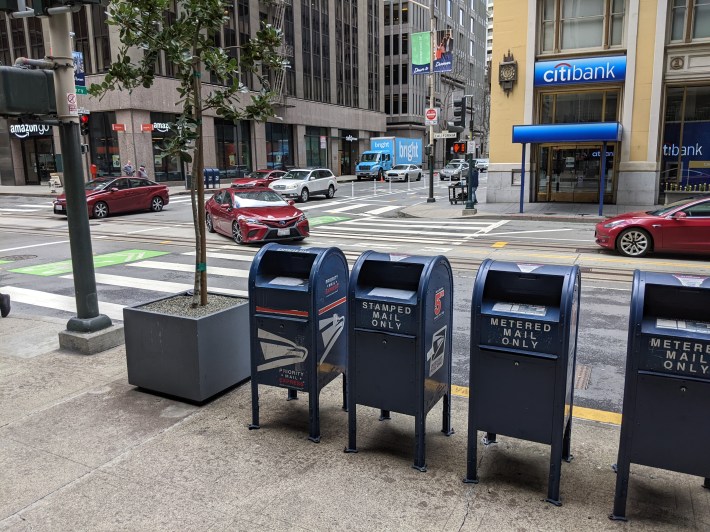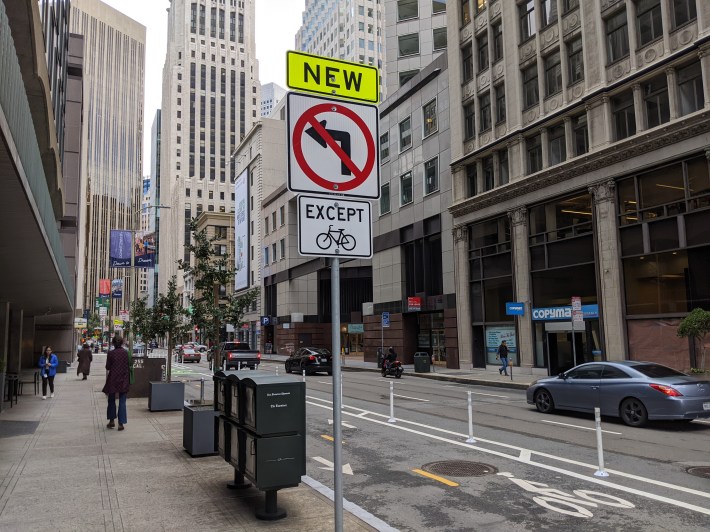San Francisco officials took advantage of a break in the rains this morning to celebrate the opening of the financial district’s first “protected” bike lane, a two-way installation on Battery from Market Street to Vallejo. “This is the right time to experiment, it’s the right time to pioneer,” said D3 Supervisor Aaron Peskin, about the new lane. He boasted about how the lane was funded by 2019’s Prop. D, a voter-approved tax on Uber and Lyft that he pushed. That created “the first protected bikeway in downtown.” Peskin was also proud of the fact that by reducing a parking lane no car capacity was lost.

“This adds to the 43 miles of protected bikeways,” said SFMTA director Jeffrey Tumlin, allowing “families and people of all ages and abilities” to get around by bike.
More from the project website:
…the Battery/Sansome Quick-Build Project will assess the feasibility of protected bikeways on one or both corridors and implement the improvements on Battery and Sansome streets from Market and Vallejo streets. In addition, the project will evaluate potential pedestrian safety improvements given the high volume of pedestrian activity, particularly at intersections.
Of course, as Streetsblog pointed out previously, this bike lane isn’t protected. It’s delineated by paint and plastic posts that aren’t sturdy enough to divert a pigeon, let alone a two-to-15 ton vehicle.
“We wanted to use materials that we could get in the ground immediately,” said SFMTA’s Jamie Parks, who was also at the event, of the multi-year project. “We’ll look at upgrading.”
Parks, as seen in the picture below, was standing in front of planters on Battery Bridge between Bush and Market, where the ceremony was held. Planters could also “get in the ground immediately” but can also deflect, or at least deter, an errant motorist before they mash someone in the bike lane.

Parks said there wasn’t room for planters–that’s obviously not true, given the size of the painted buffers around the plastic posts on Battery. They could also try narrower planters. There isn’t room only if the overriding concern is that vehicles will get damaged brushing against them. “We understand that plastic posts can’t be the long term solution,” he said when challenged.
Meanwhile, across the Bay, Emeryville does similar quick-build projects but uses posts painted to look like concrete–and the posts are interspersed with actual concrete, so drivers are truly deterred from simply running over the posts when they want to use the bike lane to overtake or stop for “just a minute” to make a delivery.
Streetsblog also finds it preposterous for Tumlin to suggest that Battery is now suitable for families or “people of all ages and abilities.” Just look at the divots in the concrete wall (pictured below) on Battery to get an idea of how often distracted or speeding motorists make mistakes that would be deadly to anyone outside of a car. That wall protects drivers from crashing over a curb and falling into the garage ramp below. Why is a massive concrete wall required–in the first iteration–to stop drivers from killing themselves, but plastic is deemed sufficient to prevent them from mashing cyclists? Why is no “experiment” required for driver safety?

Furthermore, two-way cycle tracks invite collisions with turning motorists. As any Dutch planner would explain, they require carefully thought out protected intersections (or they should only be used along waterfronts or other situations where intersections are rare). Streetsblog did a survey of Battery earlier this week. Despite the prohibition, three motorists made illegal turns across the new bike lane where it crosses California Street in about 15 minutes.
But SFMTA wants children to use this lane:

It’s sad that SFMTA, in 2023, with record fatalities due to traffic violence in 2022, is still experimenting on humans and building and boasting about such bare-bone, “better than nothing” designs.

The city keeps trying to gaslight its way to Vision Zero, but the physics of what happens when a motorist slams into a person don’t change because of straws, stripes, signs, and speeches.





